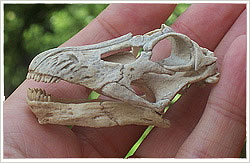1/12th scale Apatosaurus louisae
About
We all make models; building and refining models in our head is how we make sense of the world. To understand how a dinosaur is put together it's really helpful to handle each bone, look at the hidden details, see how each connects to those around it, and view an entire skeleton from all angles. That's what a good accurate scale model allows.
Here you'll find descriptions of such models; each represents the original animal as faithfully as possible. Most were produced as kits, however some are rare or long out of production and it's difficult to find information about them, so one aim of this website is simply to document them.
1/12th scale Apatosaurus louisae skull
Skeletons
Our understanding of dinosaurs has changed so much in recent years
and, with a little perseverance, good information is not hard to source.
For me, researching and refining a skeleton model is a rewarding
puzzle. Each individual bone is a challenge and a subject in itself
while a correctly articulated whole is a symphony of form, pose and
structure.
Why skeletons? Because they are the most tangible dinosaur artifacts we have. Gigantic fossil dinosaur bones are elemental, surreal, and fantastic objects that we can actually touch! They bridge the worlds of the real and the imagined better than anything I know.
Unfortunately, even dinosaur skeletons are often poorly presented, and a reconstruction in natural bone (as you will find here) is rare indeed! We seem to expect these magnificent animals remain incomplete crumbling relics; mere shadows. To be fair, one reason for this is simply that the bigger animals are so huge that creating full-scale reconstructions is prohibitively difficult and expensive. Working with scaled-down versions is a very practical and insightful alternative—not to mention great fun.

